 |
 |
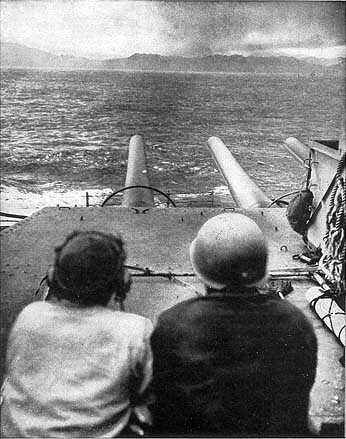 |
|
GUNS ON JAPAN. Big guns of the U. S. S. Massachusetts are trained directly on Kamaishi, important factory town on shore of Honshu, in first shelling of the Jap homeland by warships. Coordinated with this audacious attack, were more than 1,000 Third Fleet planes which rained destruction on Honshu and Hokkaido. Some of world's greatest warships were in attack on homeland. (Photo and text from a period newspaper.) |
I have several military history web sites, which draw occasional e-mails, often from the decedents of those who participated in the battles described. Sickles' Hole has drawn several requests for information on just where great-grandfather's regiment fought at Gettysburg. This site too has drawn comment from the sons and daughters of Massachusetts crew.
I recently got a letter from the son of a POW held at Kamaishi, Japan.
Mr. Butler, attached is a photo I found that Identified the USS Massachusetts with guns trained directly at Kamaishi, during the first shelling of the Japanese Homeland on July 14th 1945. The POW camp my father happened to be in that day was on the waterfront several hundred yards forward of the main target, the Iron Works. His first indication of shelling was what I believe to have been a bracketing salvo from the 5" guns. Next came the 16" rounds starting at the water and walking up the hill to the works. Dad could see plainly the ship 1.5 to 2.5 miles offshore belching smoke and fire moments before the concussion of the shells passing over hurt his hands which now covered his head.The rounds in some cases passed completely through the Works without detonating do to the thin walls of the building and while damaging the works it appeared on the outside that it was unharmed. Several days later he spotted a high altitude flight of a single plane and thought they are going to be back I bet. That mill is still standing. He was right. August 9th the shelling was repeated, only this time the camp was obliterated with many death's to the POWs. The Works was razed and the eye witness account my father tells is hair-raising.
A bit of digging confirms that the Massachusetts did bombard Kamaishi on the dates mentioned. She was, however, but one of three battleships acting as Task Unit 34.8.1. USS South Dakota was flag. The USS Indiana filed the following report of the action.
PART I SummaryA. U.S.S. INDIANA as part of Task Unit 34.8.1 bombarded the city of Kamaishi, Honshu, Japan, using the main battery only, in accordance with Commander, Battleship Squadron Two's operation order #15-45. Shipboard aircraft were not launched. U.S.S. INDIANA aviators spotted for the bombardment, flying in carrier based aircraft. The CAP was provided by Task Group 38.1. No opposition by surface or aircraft was encountered. The period covered by this report is from 0558 to 2152, 14 July 1945.
PART II Preliminaries
A. Task Unit 34.8.1 was constituted as follows:
Task Unit 34.8.1 Rear Admiral J.G. Shafroth, USN
U.S.S. SOUTH DAKOTA (BB-57)
U.S.S. INDIANA (BB-58)
U.S.S. MASSACHUSETTS (BB-59)U.S.S. CHICAGO (CA-136)
U.S.S. QUINCY (CA-71)U.S.S. STEMBEL (DD-644)
U.S.S. ABBOTT (DD-629)
U.S.S. BULLARD (DD-660)
U.S.S. CHAUNCEY (DD-667)
U.S.S. ERBEN (DD-631)
U.S.S. HALE (DD-642)
U.S.S. WALKER (DD-511)
U.S.S. BLACK (DD-666)
U.S.S. HEERMANN (DD-532)Task Unit 34.8.1 detached from Task Force 38 at 0600 and proceeded directly to Kamaishi. No training was conducted en route. Mission: Bombard "certain vital areas of the Japanese mainland in order to destroy vital industries, demoralize transportation, and lower the will to resist of the Japanese people" Own forces: Task Unit 34.8.1 approached Kamaishi in a circular air defense disposition, 4 V-Bomb. The final approach and bombardment was made in a column of battleships and cruisers with destroyer screen ahead, astern and on the disengaged sides. 0558 U.S.S. INDIANA left station in Task Group 38.1 to form on U.S.S. SOUTH DAKOTA as part of Task Unit 34.8.1. 0603 Battleship Division Eight formed column. 0705 Formed cruising disposition 4 S-Bomb, U.S.S. QUINCY and U.S.S. CHICAGO joined Task Unit 34.8.1. 0910 Sighted land bearing 235*(T). 1040 General Quarters. 1053 Deployed in bombardment disposition. 1100 Signal on Flagship " Never Forget Pearl Harbor". 1210 Opened fire with main battery. 1418 Ceased fire main battery. 1424 Formed cruising disposition 4 S-Bomb. 1436 Secured from General Quarters. 2152 Ships of Task Unit 34.8.1 ordered to report to previously assigned Task Groups. B.1 Weather: Wind 13 knots, from 084* (T).
Hits in Target Area
1. 2 in Coke Ovens, Area 9451 U
2. 4 in Open Hearths, Area 9451 P&U
3. 1 in Foundry, Area 9315 T
4. 1 in Soaking Pit, Area 9351 T
5. 1 in Gas Holder, Area 7450, causing a violent explosion.
6. 1 in Rolling Mill South, Area 9351 Y
In addition to the above, 26 salvos were seen to land in the target area.
But heavy smoke did not allow good spotting.PART III Chronological Account of Action
A. 1130 General Quarters. 1134 Course 186*. 1138 Course 210*, speed 18 knots. Formed in bombardment formation. 1144 Course 200*. 1152 course 276*, speed 22 knots. Task Group Commander ordered General Quarters. 1215 Catapulted one aircraft. 1218 Course 231*. 1225 catapulted one aircraft. 1226 course 246*. 1230 Speed 15 knots. 1246 Signal to open fire with main battery, course 186*. 1308 Course 006*. 1313 course 016*. 1343 Course 196*. 1348 Course 181* 1414 Course 001*. 1415 Ammunition allowance expended. 1420 Course 006*. 1445 Signal to cease fire. 1447 course 096*
End SPECIAL REPORT
I have found no similar report for the second bombardment, but I believe all three battleships (and likely many of the smaller vessels) returned. The columns cruised basically north-south during the bombardment, and broke off to the east. I note no mention of the POW camp in the action report. There is a discrepancy between the first paragraph's "Shipboard aircraft were not launched" and the 1215 and 1225 "catapulted one aircraft" log entries.
While one can appreciate that the sons of the POWs might have a different perspective on the Kamaishi bombardment than the sons of the navy crews, the difficulties of identifying POW camp locations must also be considered. Two of the following photos give sea and air spotter's views of the target area.
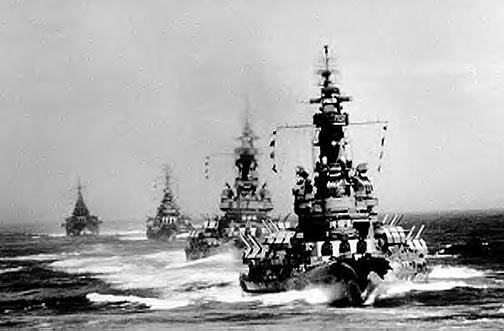 |
|
Indiana in foreground followed by Massachusetts, Quincy and Chicago Photo taken from the South Dakota |
|
|
|
|
 |
|
|
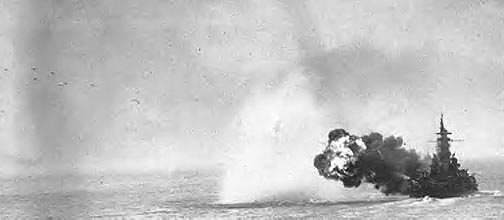 |
|
Note, outbound shells visible to the left of the picture. |
The photos of the shelling confirm the Indiana's action report, "heavy smoke did not allow good spotting". It seems that the task force was doing an area bombardment. They knew the lay out of the steel production buildings. What did they know of the POW camp?
Note in the picture of Massachusetts firing a salvo one can see a black bar towards the top of her main tower, above the cross bar of the main mast. These are the stereo telescopes of Spot One, used to determine range and direction to targets. If one can see these arms from the stern of the ship, Spot One was pointed fore or aft. Spot One was not pointed at Kamaishi.
Why was Massachusetts not looking at her target? Check the two pictures above, and the picture at the top of the page. There was a hill between the ships and the target area. There was a spotter aircraft calling targets and corrections.
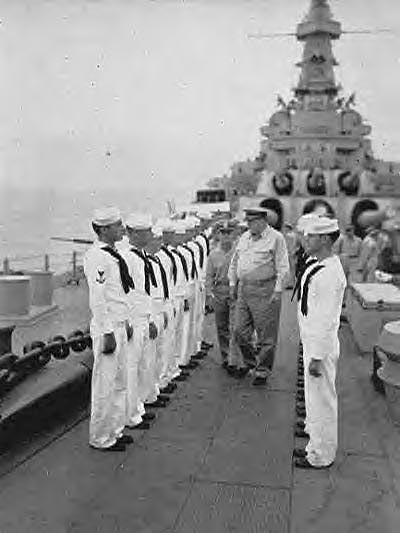 |
|
Shafroth flew his flag from the Massachusetts before shifting to the South Dakota (BB 57). South Dakota was built as a force flag ship, lacking two 5 inch mounts to provide weight allowance for a flag bridge. The admiral was a big man. According to Massachusetts legend, as repeated by the park service tour guides, he was responsible for numerous ad-lib modifications intended to let a big man pass more easily through the tight spaces of a war ship. |
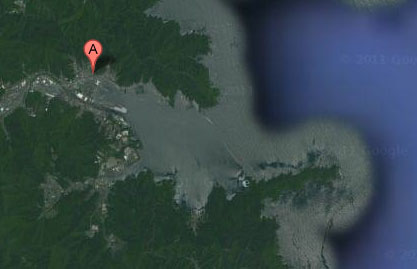 |
|
Kamaishi from Google Maps, with the A tag roughly near the target. Th US ships were apparently well to the right of the area covered in the picture. |
While the POW's son seemed ready to pass judgement on the Massachusetts or her crew for the shelling POW incident, one might more properly judge the admiral commanding.
Admiral Shafroth had spent much of the early war years investigating responsibility for the surprise at Pearl Harbor. Conspiracy theorists assert the US knew or should have known the attack was coming. Admiral Shafroth was heavily involved in the official position papers, which have been under attack by historical revisionists since. Most of Shafroth 's post war writings are on the subject of Pearl Harbor.
***
Task Force 34.8.1 was centered on three of the four South Dakota class battleships, steaming in the order of their hull numbers. The above picture of the Admiral reviewing Indiana's crew, taken on the Indiana, matches what one would see from the bow of Massachusetts. The fourth South Dakota class ship not present was USS Alabama, BB 60.
The USS Massachusetts tour guides are fond of mentioning that the first and last 16 inch shells fired by a US Battleship in anger during World War II were fired by the Massachusetts. These last shots fell on Kamaishi.
 |
Shore - Dock -
Engines - Dry-dock
- Perspectives
Anchor - 16 Inch -
George - Turret 3
- Shells - Magazines
- Jean Bart - Armor
Hatches - Five
Inchers - Inside 5" - Quad
40s - Turkey Trot
AA Directors - Sky -
Spot - Radar -
Last
Look - History -
BB Names
Massachusetts - Galveston
- Homepage - NavShips
& NavRing